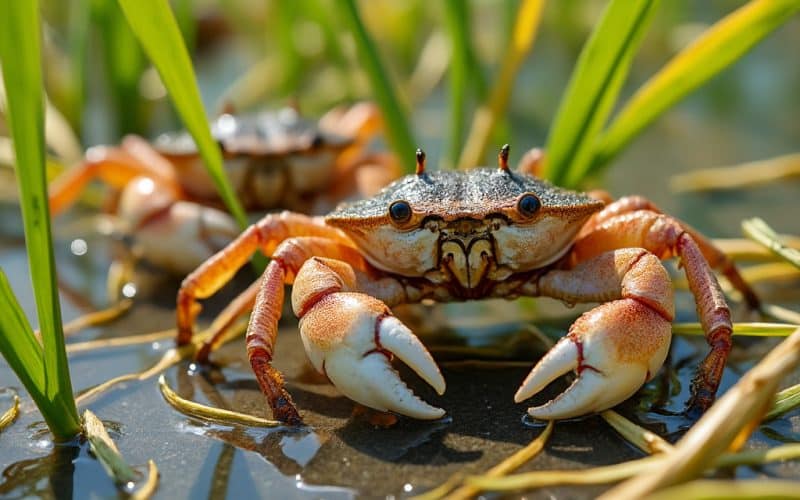
In China, the practice of rice–crab coculture / symbiosis has emerged as a sustainable agricultural model, integrating the cultivation of rice with the farming of Chinese mitten crabs (Eriocheir sinensis) within the same paddy fields.
This system has been developed over the past three decades, offering both economic and ecological benefits. Below is a video showing the practice.
Origins of Rice–Crab Coculture / Symbiosis System
The concept of integrating aquaculture with rice cultivation has deep roots in China, with practices like rice–fish coculture dating back nearly 2,000 years. These traditional methods involved raising fish in rice paddies, allowing for mutual benefits such as natural pest control and enhanced soil fertility.
Inspired by the success of these systems, Chinese farmers adapted the model to include Chinese mitten crabs, aiming to address modern agricultural challenges and enhance both economic returns and ecological sustainability.
Have you heard of Crab-Rice Symbiosis
— NaijaFarmer (@Nig_Farmer) December 2, 2024
The Chinese are doing amazing things with Agriculture
The knowledge is too much it's harder to keep up with it pic.twitter.com/NfsvVSp1iU
What is Coculture / Symbiosis System Exactly?
Co-culture or symbiosis refers to the simultaneous cultivation of two or more distinct cell types within the same environment, facilitating direct interactions between them. This method is widely employed in biological research to study cellular behaviors, communication, and the effects of various treatments in a setting that closely mimics natural physiological conditions.
In agriculture, co-culture extends to the integrated cultivation of different organisms within the same system. A notable example is the rice–crab coculture in China, where rice and Chinese mitten crabs (Eriocheir sinensis) are farmed together in paddy fields. This practice leverages the symbiotic relationships between the species to enhance productivity and sustainability.
While China has pioneered rice–crab coculture systems, other countries have adopted similar integrated agriculture–aquaculture practices. For instance, rice–prawn coculture systems are prevalent in various Asian nations, including Thailand and Vietnam. These systems involve cultivating rice alongside prawns, such as the oriental river prawn (Macrobrachium nipponense), within the same paddy fields. This approach enhances soil fertility and increases microbial diversity, contributing to sustainable agricultural practices.
Additionally, rice–crayfish coculture systems have been implemented in countries like the United States, particularly in the southern regions. These systems integrate rice cultivation with crayfish farming, optimizing resource use and providing diversified income streams for farmers. However, it’s important to note that while these integrated systems offer ecological and economic benefits, they also present challenges, such as increased water consumption and potential environmental impacts.
Various countries have adopted integrated rice–aquatic animal coculture systems, tailoring them to local species and environmental conditions to promote sustainable agriculture.
Benefits of Rice–Crab Coculture / Symbiosis System
Integrating Chinese mitten crabs into rice paddies exemplifies sustainable agriculture by harmonizing economic gains with environmental stewardship. This method enhances biodiversity, reduces reliance on chemical inputs, and promotes ecological balance, offering a viable path toward more resilient farming systems.
Here are the advantages:
- Economic Advantages: Farmers can harvest both rice and crabs from the same field, diversifying income sources and potentially increasing profitability compared to traditional rice monoculture.
- Ecological Benefits:
- Pest and Weed Control: Crabs feed on pests and weeds, reducing the need for chemical pesticides and herbicides.
- Soil Fertility Enhancement: Crab excrement acts as a natural fertilizer, enriching the soil and promoting healthier rice growth.
- Biodiversity Conservation: The system supports a diverse range of organisms, contributing to ecological balance.
- Greenhouse Gas Reduction: Studies have shown that rice–animal coculture systems can significantly reduce methane emissions from rice paddies.
Potential Drawbacks
While rice–crab coculture offers numerous benefits, it also presents challenges that require careful management. Implementing this system demands increased labor and expertise, as farmers must balance the needs of both rice and crabs.
Additionally, the integration can lead to higher water consumption, which may strain resources in areas with limited water availability. The close interaction between rice and crabs can facilitate the spread of diseases, necessitating vigilant monitoring and control measures.
Moreover, improper nitrogen fertilizer application can exacerbate greenhouse gas emissions, degrade water quality, and disrupt the balance of the rice–crab ecosystem.
These are the potential drawbacks in short:
- Increased Labor and Management Requirements: Implementing rice–crab coculture demands more intensive management and labor compared to traditional rice farming.
- Water Usage Concerns: Some coculture systems, such as rice–crayfish, have been noted for high water consumption, which could be a concern in water-scarce regions.
- Disease Management Challenges: The close interaction between rice and crabs can facilitate the spread of diseases, necessitating vigilant monitoring and control measures.
Addressing these challenges is crucial to ensure the sustainability and success of rice–crab coculture systems.
Current Results and Future Prospects
Research indicates that rice–crab coculture systems can enhance rice yields and quality. For instance, a study in the Panjin area of the Liaohe River Basin demonstrated that specific fertilization modes within the rice–crab culture system significantly improved rice yield and quality.
However, the success of such systems depends on factors like appropriate field design, optimal stocking densities, effective water quality management, and disease control strategies.
Rice–crab coculture represents a promising approach to sustainable agriculture, harmonizing economic gains with environmental stewardship. Ongoing research and technological advancements continue to refine this system, enhancing its viability and benefits.
